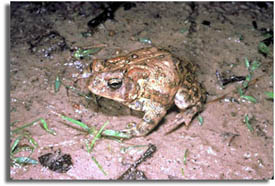 |
| UFWS Photo by Dr. Robert Thomas © |
March 15, 2004
AUSTIN, TEXAS - Government wildlife agencies and nonprofit conservation
groups recently recognized Robert K. Long, Sr. and his family for their
dedication to conserving a rare amphibian species that resides in central
Texas. The Long family has partnered with Texas Parks and Wildlife Department,
U.S. Fish and Wildlife Service and Environmental Defense to create,
enhance, and restore habitat on the family’s 540-acre ranch to benefit the
endangered Houston toad - Bufo
houstonensis. A ceremony recognizing the
partnership was held March 10 at the Long family’s property, the L & L
Ranch, in Bastrop County.
Environmental Defense has worked closely with the Long Family and other
partners during the past year to develop a Safe Harbor Agreement that
outlines specific management actions designed to benefit the Houston toad.
Safe Harbor Agreements are voluntary arrangements designed to benefit
endangered species while providing landowners assurances that they will not
incur additional restrictions on their property if they act to help the
species.
Conservation measures outlined in the agreement include activities to
facilitate the Houston toad’s reproductive success, improve the quality of
foraging and other habitat areas, and enhance movement between foraging and
breeding areas for the toad on the ranch. These management actions and the
partnerships involved with this effort represent a great effort to conserve
this species.
The Houston toad was listed as endangered under the federal Endangered
Species Act on Oct. 13, 1970. An endangered species is one that is in
danger of extinction throughout all or a significant portion of its range.
The Houston toad varies in color from light brown to reddish to gray. The
underside is usually pale with small, dark spots. It was historically known
to occur in 12 Texas counties, but is now believed to only reside in about
nine counties.
The most robust of the remaining Houston toad populations occurs in Bastrop
County, where it is associated with the "Lost Pines" ecosystem that is
characterized by pine and/or oak woodlands and deep sandy soils. The
presence of water is another important habitat component for the Houston
toad. Breeding occurs in shallow, rain-fed puddles and pools that persist
long enough for the eggs laid to hatch into tadpoles and metamorphose into
toadlets. Houston toads are known to burrow into sand or hide under rocks,
logs, and leaf litter during harsh weather conditions, which makes
determining the distribution of this species outside the breeding season
extremely difficult.
|